Blog
VPPRN 6-Month Check-in Forms – Community Dashboard
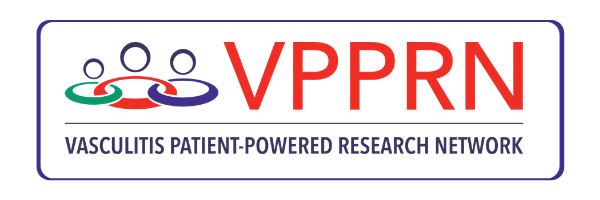
6-Month Check-In Forms
VPPRN Community Dashboard | January 2023
Take a look below at what we learned from the VPPRN community about FATIGUE, PAIN, FLARES and SYMPTOMS OF VASCULITIS at the January 2023 check-in.
What did we learn about FATIGUE and VASCULITIS?
We learned that most patients (over 88%) experience some fatigue related to their vasculitis.
Fatigue is not uncommon among patients with vasculitis. Patients may have fatigue even if other vasculitis symptoms are under control.
By completing the VPPRN check-in forms every 6 months, it will tell us more about fatigue and its impact on quality of life for patients living with vasculitis.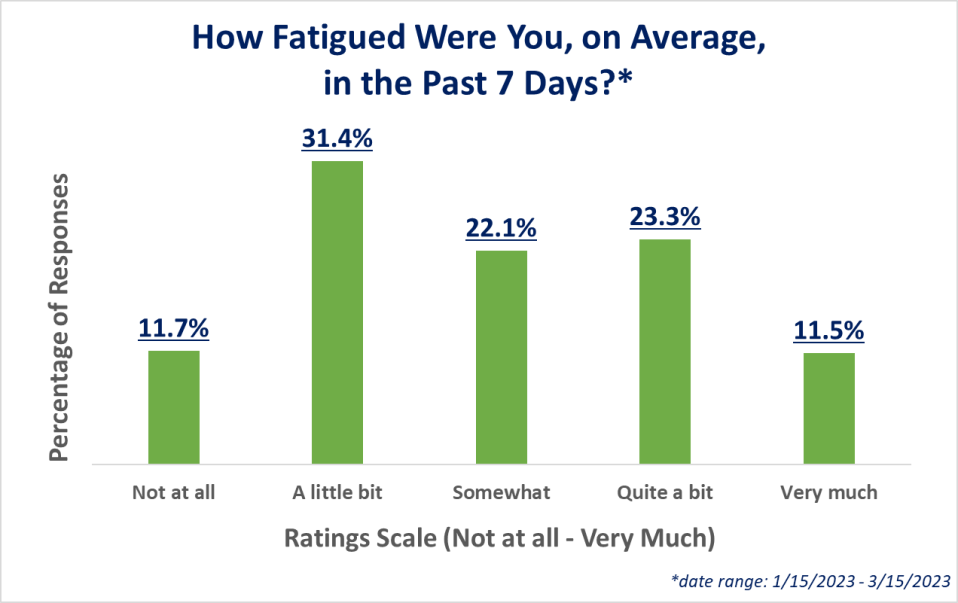
What did we learn about PAIN and VASCULITIS?
Approximately 50% of patients experienced little to no pain on average, with scores ranging from 0-2 on a scale of 0-10.
Alternatively, almost 30% of patients with vasculitis experienced moderate to severe pain with scores 5 and above.
Why do some patients experience more pain than others? That is a good question and one that the VPPRN wants to understand more as we collect data over time with our 6-month check-in forms.
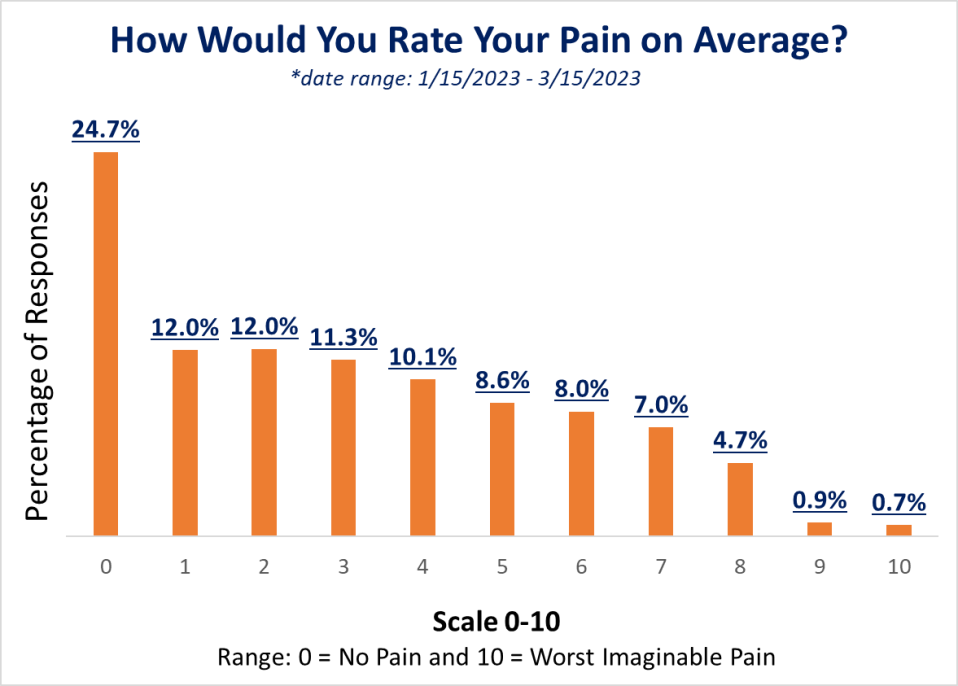
What did we learn about FLARES and VASCULITIS?
About two-thirds of patients in the VPPRN community did not report a vasculitis flare in the past 6 months. This is encouraging to see.
We do, however, see a little over 26% of patients who did report a flare.
To better understand why some experience flares and some do not, we need the VPPRN community to provide patient data to do the research needed to find answers. Patients power research. Please continue to share your health updates with us and continue to stay engaged in research.
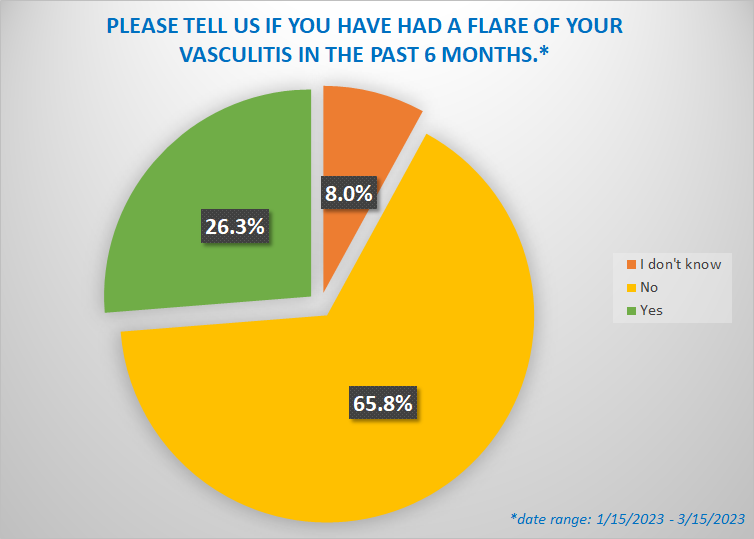
What did we learn about SYMPTOMS OF VASCULITIS?
Most patients reported as either having no symptoms of vasculitis (22.7% with score = 0) or experiencing moderate symptoms (20.8% with score = 5) over the past 28 days.
While the majority of the VPPRN community scored on the lower half of the scale (76.2% with scores 0-5 on a scale of 0-10), there were approximately 9% who scored on the higher end, with scores ranging from 8-10.
Why the difference? We can’t say for sure.
We need more research to better understand why some do better than others. The data the VPPRN community provides to the VPPRN is mobilizing our team of doctors and researchers with the information they need to work towards improving the quality of life for all patients across all vasculitis types and ages. The more data we have, the more answers we can find.
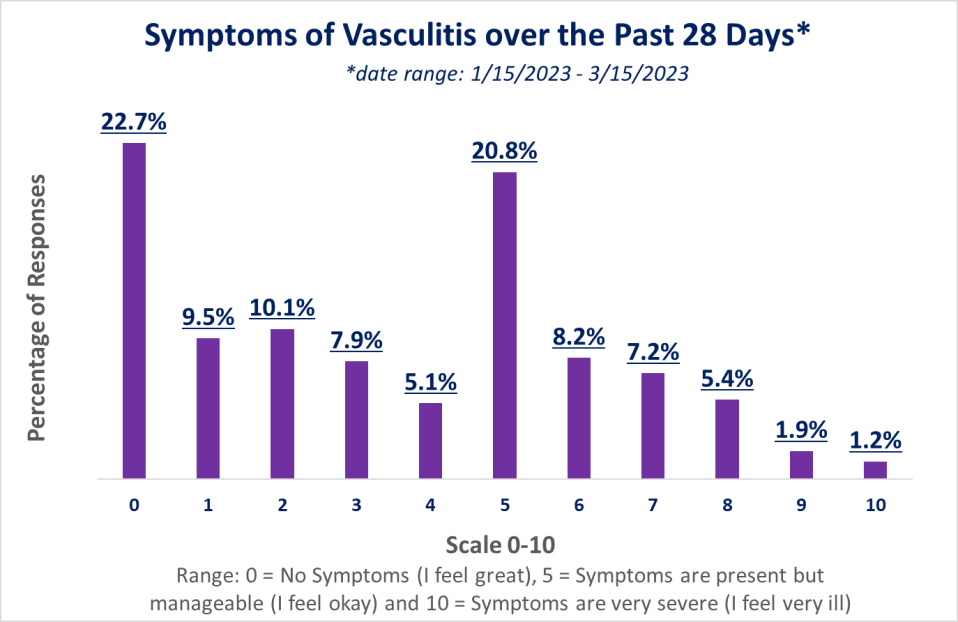
HOW DO YOU COMPARE TO OTHERS IN THE VPPRN COMMUNITY?
Click below and see how patients with each type of vasculitis compare with the VPPRN community as a whole.
Compared to patients with other forms of vasculitis, patients with Behçet’s Disease (BD) reported higher scores for fatigue, pain, flares, and symptoms of vasculitis.
Fatigue: 56.1% of patients with BD reported “quite a bit” or “very much” fatigue in the past 6 months. This is higher than the 34.8% in the VPPRN community.
Pain: Patients with BD reported more pain in the past 6 months. 4.9% of patients with BD reported no pain. This is less than the 24.7% in the VPPRN community.
Flare Reporting: Patients with BD reported more flares in the past 6 months (66.7%) compared to 26.3% in the VPPRN community.
Symptoms of Vasculitis: Patients with BD scored their symptoms of vasculitis higher over the past 28 days. 4.9% of patients with BD reported no symptoms of vasculitis. This is less than the 22.7% in the VPPRN community.
If you have concerns about your health scores, please discuss with your rheumatologist or primary care provider.
Compared to patients with other forms of vasculitis, patients with central nervous system vasculitis (CNSV) reported different scores for fatigue, pain, flare reporting, and symptoms of vasculitis.
Fatigue: 19.4% of patients with CNSV reported “very much” fatigue in the past 6 months. This is higher than the 11.5% reported from the VPPRN community.
Pain: Patients with CNSV reported more pain in the past 6 months. 13.9% patients with CNSV experienced no pain, compared to 24.7% in the VPPRN community.
Flare Reporting: Patients with CNSV reported fewer flares in the past 6 months (18.9%) compared to 26.3% in the VPPRN community.
Symptoms of Vasculitis: Patients with CNSV scored their symptoms of vasculitis higher over the past 28 days. 13.9% of patients with CNSV reported no symptoms of vasculitis, compared to 22.7% in the VPPRN community.
If you have concerns about your health scores, please discuss with your rheumatologist or primary care provider.
Compared to patients with other forms of vasculitis, patients with cryoglobulinemic vasculitis (cryoglobulinemia) reported higher scores for fatigue, pain, flares, and symptoms of vasculitis.
Fatigue: 33.9% of patients with cryoglobulinemic vasculitis reported “quite a bit” of fatigue in the past 6 months, compared to 23.3% in the VPPRN community.
Pain: Patients with cryoglobulinemic vasculitis reported more pain in the past 6 months. 16.1% of patients with cryoglobulinemic vasculitis reported no pain. This is less than the 24.7% in the VPPRN community.
Flare Reporting: Patients with cryoglobulinemic vasculitis reported more flares in the past 6 months (51.6%) compared to 26.3% in the VPPRN community.
Symptoms of Vasculitis: Patients with cryoglobulinemic vasculitis scored their symptoms of vasculitis higher over the past 28 days. 6.5% of patients with cryoglobulinemic vasculitis reported no symptoms of vasculitis. This is less than the 22.7% in the VPPRN community.
If you have concerns about your health scores, please discuss with your rheumatologist or primary care provider.
Compared to patients with other forms of vasculitis, patients with eosinophilic granulomatosis with polyangiitis (EGPA) reported similar scores for fatigue, pain, and flare reporting. Patients with EGPA, however, scored their symptoms of vasculitis higher than others in the VPPRN community.
Fatigue: 12.1% of patients with EGPA reported no fatigue in the past 6 months. This is similar to the 11.7% reported in the VPPRN community.
Pain: 77.7% of patients with EGPA reported no to moderate pain (scores 0-5) in the past 6 months. This is comparable to the 78.7% in the VPPRN community who reported those same scores.
Flare Reporting: 27.3% of patients with EGPA reported a flare in the past 6 months. This is similar to the 26.3% in the VPPRN community who reported a flare within the same timeframe.
Symptoms of Vasculitis: Patients with EGPA scored their symptoms of vasculitis higher over the past 28 days. 10.8% of patients with EGPA reported no symptoms of vasculitis, compared to 22.7% in the VPPRN community.
If you have concerns about your health scores, please discuss with your rheumatologist or primary care provider.
Compared to patients with other forms of vasculitis, patients with giant cell (temporal) arteritis (GCA) reported similar scores for fatigue, pain, and flare reporting. We do see differences in the scores for symptoms of vasculitis, with a higher percentage of patients with GCA reporting no symptoms at all.
Fatigue: 12.3% of patients with GCA reported no fatigue in the past 6 months. This is similar to the 11.7% in the VPPRN community.
Pain: 28.4% of patients with GCA reported no pain in the past 6 months. This is comparable to the 24.7% in the VPPRN community.
Flare Reporting: 29.4% of patients with GCA reported a flare in the past 6 months. This is similar to the 26.3% in the VPPRN community who reported a flare.
Symptoms of Vasculitis: Patients with GCA scored their symptoms of vasculitis lower over the past 28 days. 30.9% of patients with GCA reported no symptoms of vasculitis, compared to the 22.7% in the VPPRN community.
If you have concerns about your health scores, please discuss with your rheumatologist or primary care provider.
Compared to patients with other forms of vasculitis, patients with granulomatosis with polyangiitis (GPA) reported similar scores for fatigue and symptoms of vasculitis. However, there were differences in the scores for pain and flare reporting.
Fatigue: 12.4% of patients with GPA reported no fatigue in the past 6 months. This is similar to the 11.7% reported in the VPPRN community.
Pain: 83.9% of patients with GPA reported no to moderate pain (scores 0-5) in the past 6 months. This is comparable to the 78.7% in the VPPRN community.
Flare Reporting: Patients with GPA reported fewer flares in the past 6 months (16.6%) compared to 26.3% in the VPPRN community.
Symptoms of Vasculitis: 27.5% of patients with GPA reported no symptoms of vasculitis. This is similar to the 22.7% in the VPPRN community.
If you have concerns about your health scores, please discuss with your rheumatologist or primary care provider.
Compared to patients with other forms of vasculitis, patients with IgA vasculitis (Henoch-Schönlein) reported similar scores for fatigue. We do see differences in the scores for pain, symptoms of vasculitis, and reporting of flares.
Fatigue: 9.1% of patients with IgA vasculitis reported no fatigue in the past 6 months. This is similar to the 11.7% reported in the VPPRN community.
Pain: Patients with IgA vasculitis reported more pain in the past 6 months. 36.4% of patients with IgA Vasculitis reported moderate to severe pain (scores 5-10). This is higher than the 29.9% in the VPPRN community.
Flare Reporting: Patients with IgA vasculitis reported more flares in the past 6 months (39.5%) compared to 26.3% in the VPPRN community.
Symptoms of Vasculitis: Patients with IgA vasculitis scored their symptoms of vasculitis lower over the past 28 days. 30.3% of patients with IgA Vasculitis reported no symptoms at all. This is higher than the 22.7% in the VPPRN community.
If you have concerns about your health scores, please discuss with your rheumatologist or primary care provider.
Compared to patients with other forms of vasculitis, patients with microscopic polyangiitis (MPA) reported similar scores for fatigue. There were differences in the scores for pain, flare reporting, and symptoms of vasculitis.
Fatigue: 14.4% of patients with MPA reported no fatigue in the past 6 months. This is similar to the 11.7% in the VPPRN community.
Pain: Patients with MPA reported less pain in the past 6 months. 31.2% of patients with MPA reported no pain in the past 6 months, compared to 24.7% in the VPPRN community.
Flare Reporting: Patients with MPA reported fewer flares in the past 6 months (19.4%) compared to 26.3% in the VPPRN community.
Symptoms of Vasculitis: Patients with MPA scored their symptoms of vasculitis lower over the past 28 days. 31.2% of patients with MPA reported no symptoms at all, compared to 22.7% in the VPPRN community.
If you have concerns about your health scores, please discuss with your rheumatologist or primary care provider.
Compared to patients with other forms of vasculitis, patients with polyarteritis nodosa (PAN) reported similar scores for fatigue, pain, and flare reporting. There were differences in the scores for symptoms of vasculitis.
Fatigue: 14.6% of patients with PAN reported no fatigue in the past 6 months. This is similar to the 11.7% in the VPPRN community.
Pain: 78.0% of patients with PAN reported no to moderate pain (scores 0-5) in the past 6 months. This is comparable to the 78.7% in the VPPRN community.
Flare Reporting: 29.3% of patients with PAN reported a flare in the past 6 months. This is similar to the 26.3% in the VPPRN community.
Symptoms of Vasculitis: Patients with PAN scored their symptoms of vasculitis lower over the past 28 days. 29.3% of patients with PAN reported no symptoms at all, compared to 22.7% in the VPPRN community.
If you have concerns about your health scores, please discuss with your rheumatologist or primary care provider.
Compared to patients with other forms of vasculitis, patients with Takayasu’s Arteritis (TAK) reported similar scores for fatigue and symptoms of vasculitis. However, there were differences in the scores for pain and reporting of flares.
Fatigue: 9.1% of patients with TAK reported no fatigue in the past 6 months. This is similar to the 11.7% in the VPPRN community.
Pain: Patients with TAK reported more pain in the past 6 months. 42.4% of patients with TAK reported moderate to severe pain (scores 5-10). This is higher than the 29.9% in the VPPRN community.
Flare Reporting: Patients with TAK reported fewer flares in the past 6 months (17.9%) compared to 26.3% in the VPPRN community.
Symptoms of Vasculitis: 18.2% of patients with TAK reported no symptoms of vasculitis over the past 28 days. This is similar to the 22.7% in the VPPRN community.
If you have concerns about your health scores, please discuss with your rheumatologist or primary care provider.
Compared to patients with other forms of vasculitis, patients with urticarial vasculitis reported similar scores for fatigue, pain, and symptoms of vasculitis. We do see a difference in flare reporting.
Fatigue: 9.1% of patients with urticarial vasculitis reported no fatigue in the past 6 months. This is similar to the 11.7% in the VPPRN community.
Pain: 27.3% of patients with urticarial vasculitis reported no pain in the past 6 months. This is comparable to the 24.7% in the VPPRN community.
Flare Reporting: Patients with urticarial vasculitis reported more flares in the past 6 months (45.7%) compared to 26.3% in the VPPRN community.
Symptoms of Vasculitis: 24.2% of patients with urticarial vasculitis reported no symptoms of vasculitis over the past 28 days. This is similar to the 22.7% in the VPPRN community.
If you have concerns about your health scores, please discuss with your rheumatologist or primary care provider.
Compared to patients with other forms of vasculitis, patients with other/suspected diagnosis reported similar scores for fatigue, pain, and symptoms of vasculitis. The differences we see are in the reporting of flares.
Fatigue: 10.6% of patients with other/suspected diagnosis reported no fatigue in the past 6 months. This is similar to the 11.7% in the VPPRN community.
Pain: 22.3% of patients with other/suspected diagnosis reported no pain in the past 6 months. This is comparable to the 24.7% in the VPPRN community.
Flare Reporting: Patients with other/suspected diagnosis reported more flares in the past 6 months (43.0% compared to 26.3% in the VPPRN community).
Symptoms of Vasculitis: 18.1% of patients with other/suspected diagnosis reported no symptoms of vasculitis over the past 28 days. This is similar to the 22.7% in the VPPRN community.
If you have concerns about your health scores, please discuss with your rheumatologist or primary care provider.
There is still much to learn about vasculitis, but the VPPRN community can change that. The VPPRN is a PATIENT-POWERED network which means that PATIENTS POWER VASCULITIS RESEARCH.
The more patient data our VPPRN community provides, the more answers we can find to improve the understanding, diagnosis, and treatment for patients across all types of vasculitis. Why do some patients do better than others? How can we better understand why these differences exist? The answer is research.
More research is coming!
We’ll be in touch as new research studies open. Please keep an eye out for those emails – we want to hear from you and we need your participation! In the meantime, please stay involved, stay engaged, and please continue to share your health updates every January and July.
We are stronger together. Together we make a difference.
THANK YOU to all 1,326 VPPRN members who shared their health updates with us!
We appreciate your enthusiasm and continued engagement with the VPPRN!
Questions? Christine Yeung, our Network Manager is here to help. Email, call or text at any time and we can provide the assistance you need.
- Email: [email protected] or [email protected]
- Mobile: (215) 200-6147
- Business hours: Monday-Friday between 8AM-5PM ET

